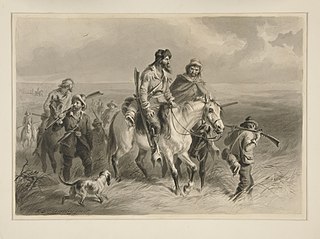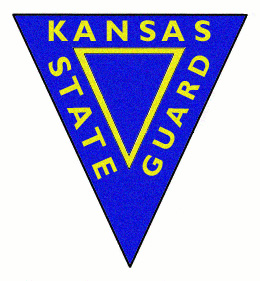Related Research Articles

Bleeding Kansas, Bloody Kansas, or the Border War was a series of violent civil confrontations in Kansas Territory, and to a lesser extent in western Missouri, between 1854 and 1859. It emerged from a political and ideological debate over the legality of slavery in the proposed state of Kansas.

The Territory of Kansas was an organized incorporated territory of the United States that existed from May 30, 1854, until January 29, 1861, when the eastern portion of the territory was admitted to the Union as the free state of Kansas.

Border ruffians were proslavery raiders who crossed into the Kansas Territory from Missouri during the mid-19th century to help ensure the territory entered the United States as a slave state. Their activities formed a major part of a series of violent civil confrontations known as "Bleeding Kansas", which peaked from 1854 to 1858. Crimes committed by border ruffians included electoral fraud, intimidation, assault, property damage and murder; many border ruffians took pride in their reputation as criminals. After the outbreak of the American Civil War in 1861, many border ruffians fought on the side of the Confederate States of America as irregular bushwhackers.
The Wyandotte Constitution is the constitution of the U.S. state of Kansas.
The Pottawatomie massacre occurred on the night of May 24–25, 1856, in the Kansas Territory, United States. In reaction to the sacking of Lawrence by pro-slavery forces on May 21, and the telegraphed news of the severe attack on Massachusetts Senator Charles Sumner, John Brown and a band of abolitionist settlers—some of them members of the Pottawatomie Rifles—responded violently. Just north of Pottawatomie Creek, in Franklin County, they killed five pro-slavery settlers in front of their families.
The Pottawatomie Rifles was a group of about one hundred abolitionist settlers of Franklin and Anderson County, Kansas, both of which are along Pottawatomie Creek. The band was formed in the fall of 1855, during the Bleeding Kansas period, as an armed militia to counter growing pro-slavery presence: an influx of men known as border ruffians, from the neighboring slave state of Missouri.

California's involvement in the American Civil War included sending gold east to support the war effort, recruiting volunteer combat units to replace regular U.S. Army units sent east, in the area west of the Rocky Mountains, maintaining and building numerous camps and fortifications, suppressing secessionist activity and securing the New Mexico Territory against the Confederacy. The State of California did not send its units east, but many citizens traveled east and joined the Union Army there, some of whom became famous.

The Battle of Black Jack took place on June 2, 1856, when antislavery forces, led by the noted abolitionist John Brown, attacked the encampment of Henry C. Pate near Baldwin City, Kansas. The battle is cited as one incident of "Bleeding Kansas" and a contributing factor leading up to the American Civil War of 1861 to 1865.

At the outbreak of the American Civil War in April 1861, Kansas was the newest U.S. state, admitted just months earlier in January. The state had formally rejected slavery by popular vote and vowed to fight on the side of the Union, though ideological divisions with neighboring Missouri, a slave state, had led to violent conflict in previous years and persisted for the duration of the war.

Mount Oread is a hill in Lawrence, Kansas, upon which the University of Kansas, and parts of the city of Lawrence, Kansas, are located. It sits on the water divide between the Kansas River and the Wakarusa River rivers. It was named after the long defunct Oread Institute in Worcester, Massachusetts, where many of the settlers of Lawrence moved from prior to the American Civil War. The hill was originally called Hogback Ridge by many Lawrence residents until the Oread name was adopted in 1864, two years after the university was founded.
The Battle of Osawatomie was an armed engagement that occurred on August 30, 1856, when 250–400 pro-slavery Border ruffians, led by John W. Reid, attacked the town of Osawatomie, Kansas, which had been settled largely by anti-slavery Free-Staters. Reid was intent on destroying the Free-State settlement and then moving on to Topeka and Lawrence to do more of the same. Abolitionist John Brown first learned of the raiders when they shot his son Frederick. With just 40 or so men, Brown tried to defend the town against the pro-slavery partisans, but ultimately was forced to withdraw; five Free-Staters were killed in the battle, and the town of Osawatomie was subsequently looted and burned by Reid's men. The battle was one of a series of violent clashes between abolitionists and pro-slavery partisans in Kansas and Missouri during the Bleeding Kansas era.

The Marais des Cygnes Massacre Site, also known as Marais des Cygnes Massacre Memorial Park, is a state historic site near Trading Post, Kansas that commemorates the 1858 massacre of the same name. On May 19, 1858, during a period of political instability and sporadic violence known as Bleeding Kansas, a group of pro-slavery border ruffians captured 11 abolitionist free-staters. The prisoners were forced to a nearby ravine, where 10 of them were shot, resulting in five fatalities. The abolitionist John Brown later built a fort near the site. The first commemoration at the site was two stone markers erected by men of the 3rd Iowa Cavalry Regiment in 1864, although these monuments had been destroyed by souvenir hunters by 1895. In 1941, the land where the massacre occurred, as well as an 1870s-era house constructed by a friend of Brown, were transferred to the state of Kansas. The site was listed on the National Register of Historic Places in 1971 and designated a National Historic Landmark in 1974. The Kansas Historical Society administers the site, which is interpreted by signage and a hand-cranked audio recording.

The Kansas State Guard was the official state defense force of the state of Kansas during each of the world wars. The unit was first created during World War I, and was later reactivated during World War II. When the Kansas National Guard was federalized and deployed during each of the world wars, the state of Kansas was forced to raise and maintain its own military force in order to protect against saboteurs, quell riots, and perform other duties which would normally fall to the National Guard. Unlike the National Guard, which could be federalized and deployed abroad, the State Guard was funded and equipped solely by the state and as such was immune to deployment. The Kansas State Guard is authorized under Kansas law. In 2007, the Kansas Legislature considered a bill which would create a modern Kansas State Defense Force. The bill did not pass.
Franklin is a ghost town in Douglas County, Kansas, United States. Established as a proslavery stronghold, the town played a key role in the "Bleeding Kansas" conflict that troubled the territory in the 1850s.
Franklin's Fort was a small fortification that had been erected in Franklin, Douglas County, Kansas by pro-slavery settlers. During the "Bleeding Kansas" period, the fort was the site of two minor battles between pro- and anti-slavery factions.
The Battle of Fort Titus occurred during conflicts in the Kansas Territory between abolitionist and pro-slavery militias prior to the American Civil War. The era is known as Bleeding Kansas.
Fort Saunders, 4 miles (6.4 km) southeast of Clinton, Kansas, and 12 miles (19 km) southwest of Lawrence, Kansas, was owned by James D. Saunders, a militia captain. What little was left of Clinton disappeared during construction of the Clinton Lake in the 1960s; only an outbuilding that was converted into a museum remains.
New Georgia's Fort was located in Miami County, Kansas, southeast of Osawatomie. During the partisan warfare in Kansas Territory in 1856 commonly known as Bleeding Kansas, a colony of Southerners, possibly all Georgians, established New Georgia. This colony was located on the Marias des Cygnes River. A blockhouse fort was constructed there and entrenchments were begun but the fort destroyed before the entrenchments could be completed. Northern settlers in the area claimed settlers at New Georgia harassed them. In reality, some settlers from both the North and South had groups who caused trouble with their neighbors.
Fort Titus was the fortress residence of pro-slavery advocate Henry T. Titus, built in Kansas in April 1856, during a period when forces aligned with Titus came into conflict with free-state settlers. The wider conflict, which emerged from a political and ideological debate over the legality of slavery in the proposed state of Kansas, became known as Bleeding Kansas.
Newell W. Spicer was a Union Army lieutenant colonel of volunteers during the American Civil War and a commander of the 1st Regiment Kansas Volunteer Infantry. He was also a leader of pro-abolitionist forces during Bleeding Kansas, a violent period in the history of Kansas when factions fought over proposals to abolish slavery in that state.
References
- ↑ Etcheson, Nicole. "Labouring for the Freedom of This Territory" (PDF). KSHS.
- 1 2 "Keep the Flag to the Front - Part 3 - Kansas Historical Society". www.kshs.org. Retrieved 5 January 2023.
- 1 2 3 Martha B. Caldwell. "The Stubbs". www.kshs.org. Retrieved 5 January 2023.
- ↑ Private Laws of the Territory of Kansas. S.W. Driggs. 1856. p. 33. Retrieved 5 January 2023.
- ↑ "Our Correspondence". The Kansas State Journal. Lawrence, Kansas. 6 June 1861.
- ↑ Roe, Jason. "The Founding of Lawrence, Kansas". Civil War on The Western Border. Retrieved 5 January 2023.
- ↑ "Invitation to Washington's Birthday Ball - Kansas Memory ada- Kansas Historical Society". www.kshs.org. Retrieved 5 January 2023.
- 1 2 Hill Peebles Wilson (19 February 2015). John Brown Soldier of Fortune. Creative Media Partners, LLC. ISBN 9781296392888 . Retrieved 6 January 2023.
- ↑ William E. Connelley. "A Standard History of Kansas and Kansans". www.ksgenweb.org. p. 30. Retrieved 6 January 2023.
- ↑ George Washington Brown. Reminiscences of Old John Brown: Thrilling Incidents of Border Life in Kansas. ISBN 1236993667.
- ↑ Richard J. Hinton (1894). John Brown and his men: with some account of the roads they traveled to reach Harper's Ferry. New York: Funk & Wagnalls Company. ISBN 1418189294.
- ↑ "OHJ Archive". resources.ohiohistory.org. Retrieved 9 January 2023.